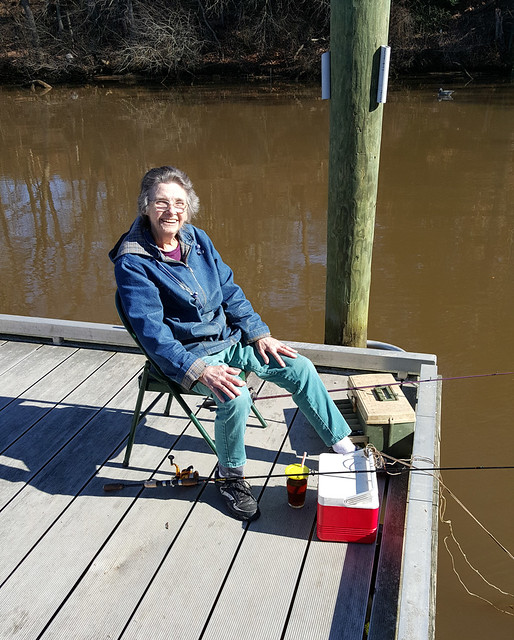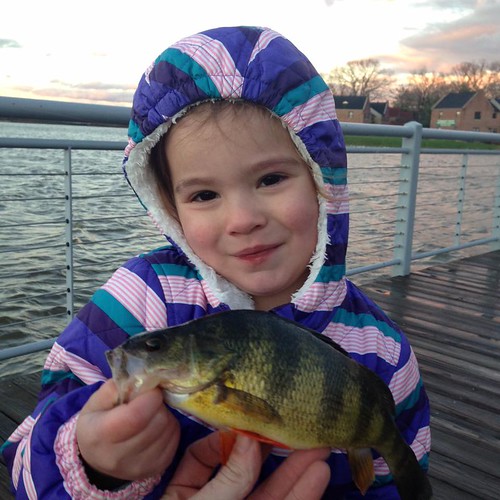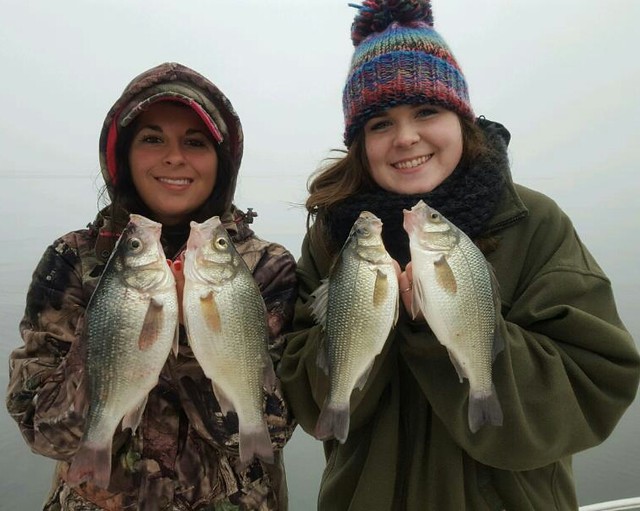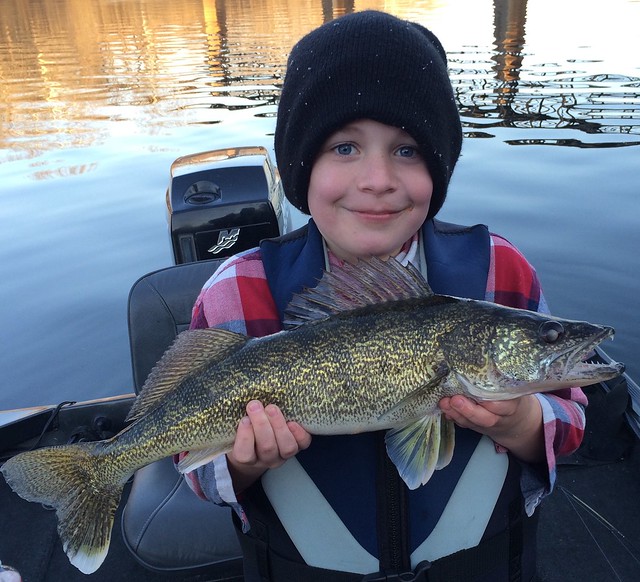By: Keith Lockwood
Marylanders have seen some tough weather in the past month and most of the snow has melted, leaving only the largest piles in most areas, with more snow remaining in the western counties. The leftover snow piles remind us of our recent toils, whether they were a trusty snow shovel or heavy equipment. A recent warm front has made it much more enjoyable to try some fishing and bask in the warm sun. Sylvia Miller took advantage of a warm sunny day to go fishing on the Choptank River near Greensboro. Although her goal was to catch some yellow perch; she was rewarded with a chance to get out of the house and enjoy a warm sunny afternoon and the peace and relaxation that all fishermen know well.

Photo Courtesy of Jim Thompson
Although it may be cold outside, fisheries biologists are busy in the field stocking trout, conducting the blue crab winter dredge survey and sampling resident fish species in the upper bay. The winter resident fish survey is accomplished during the month of January and February at sampling sites in the upper bay with 144, 10 minute tows with a 30' trawl. The research vessel stationed at the Cooperative Oxford Laboratory and captained by DNR Captain Mike Simonsen carries a crew of biologists from the Matapeake Field Office, supervised by Paul Piavis. Crews sample the fish that are brought aboard for species and quantities to gain valuable information on resident species such as white perch, channel catfish, striped bass and yellow perch.

Photos by Mike Simonsen
Recreational fishermen who wish to catch their own minnows in a minnow trap have long been hampered by the regulation that they must own private waterfront property, or have permission to set their traps off private waterfront property. The Fisheries Service has proposed a new regulation effective March 12, 2016 that would allow recreational fishermen to set a minnow trap off public property. The action is stated below. The purpose of this action is to expand the use of traps. Currently, minnow traps are only allowed to be used if tied off on your private property, or the private property of someone who has given you permission. Someone who does not own riparian property, or know someone that does own property, cannot catch their own minnows. The Department has heard from a number of people who have been frustrated by their inability to catch their own bait because of the land-ownership requirement. The proposed action allows the use of a trap on public property as long as the owner of the trap is present in the area and is attending the trap. The requirement for attending the trap is necessary because it is public property. Unattended gear on public property is not authorized. The proposed action also clarifies that the gear used for harvesting clams, crabs and oysters recreationally is specified elsewhere in statute and regulation. This chapter does not apply to those species.
Also of interest to largemouth bass fishermen is the Annual Black Bass Roundtable meeting that will be held on February 4th at the DNR office building in Annapolis. Here are the agenda, times and address for the meeting. The Fisheries Service with have a few staff biologists to answer your questions at the Pasadena Sportfishing Flea Market next weekend. The show is being held once again this year at the Earleigh Heights Volunteer Fire Company at 161 Ritchie Hwy (Rt. 2) on February 13th and 14th from 8 am to 2 pm each day. Staff from Fisheries Service will also be at the Great American Outdoors Show in Harrisburg PA for one weekend, on February 13-14.
This week's warming trend has done much to melt the snow and ice but water temperatures will of course remain close to freezing in most areas. In the upper bay tributary rivers yellow perch are holding in some of the deeper holes in the lower parts of the rivers such as the Northeast, Bush and Chester. Yellow perch are holding in the deeper holes off Perryville often in 50' depths or more. It will take a good sinker and small jigs or hooks tipped with minnows or worms to entice them to bite at that depth. In the rivers where yellow perch are staged in deeper waters lighter weights will get one down to where the perch are. Chain pickerel are one fish that likes cold water and they inhabit just about every tributary to the Chesapeake. They will be found in the middle and upper reaches of the rivers and most anything that moves through the water in the form of a lure tends to get their attention. Ava Lowers was a lucky girl when her uncle took her fishing at Wilson Point Park near Middle River recently and she caught her first yellow perch for 2016 on her trusty Barbie fishing outfit.

Photo Courtesy of Montana Grant
There has also been some yellow perch action in rivers and creeks farther down the bay. One of the more noteworthy locations is Marshyhope Creek which is a tributary of the Nanticoke River. Yellow perch are staged in some of the deeper holes in the lower part of the creek and are being caught on minnows worked slowly along the bottom. A good depth finder is a big help in locating schools of yellow perch. This situation can be duplicated in other tidal rivers such as the Bush, Magothy, Tuckahoe and Wicomico Rivers just to name a few. These areas are also the home of chain Pickerel and they can be found along shoreline edges and often the larger pickerel will be found in deeper waters. Channel catfish may also be part of the mix when fishing the deeper holes.
Water temperatures in the middle bay region are running at 38° on the surface and down to about 35" of water. Striped bass and white perch are holding in the deeper channels such as the shipping channel and anyone going over the Bay Bridge may have noticed a few commercial boats stationed along the eastern edge of the shipping channel off Kent Island tending their nets. There are striped bass stacked up behind the Bay Bridge abutments and rock piles and can offer some catch and release action. One will find them stacked like cordwood and when jigging snagged fish may outnumber those that are actually caught in the mouth. The warm water discharge at the Calvert Cliffs Power Plant always starts to attract striped bass and fishermen later on this month for some catch and release action. Angelina Watts came home for the weekend from college and brought her roommate Carissa Arillo and dad could not pass up the opportunity to take the girls out for a little white perch fishing off Kent Island. Small jigs tipped with pieces of bloodworms worked in the deep channel did the trick for these girls.

Photo by Rich Watts
Sunday I took advantage of the mild weather and went for a canoe paddle in the upper Choptank River and was entertained by several fair sized striped bass that were trying to soak up the warmth of the sun in the shallows. My passage of course disturbed them and they torpedoed for deeper water and safety. I suspect these are most likely males who are the vanguard of the 2016 spawning run. We are still of course in the dead of winter but there are a few positive signs out there that spring will eventually arrive.
Freshwater fishing has taken a new step this week as the pre-season trout stocking has begun. Middle Creek in Frederick County received a mix of 1,000 rainbow and golden rainbow trout on February 1st. The South Branch of the Patapsco received 400 rainbows and golden rainbows on Tuesday and Elkhorn Lake 600 rainbows and golden rainbows. Anglers can receive stocking information when and where trout are being stocked by checking out the trout stocking website or by becoming a subscriber to the Fisheries Service email subscription list.
Ice fishing conditions at Deep Creek Lake and other popular lakes in western Maryland has been tenuous for the past month and present. Some of the cove areas on Deep Creek Lake such as Green Glad, Sky Valley, Harvey's and North Cove had been offering some ice fishing but conditions are rapidly deteriorating. Yellow perch, bluegills and chain pickerel have been the principal catches so far since only the shallower waters could be fished. This is an interesting photo from a perspective not normally encountered by ice fishermen.

Courtesy of Bill Linder
John Mullican sent in this report from the upper Potomac River. Fishing on the upper Potomac has settled into winter mode with location and timing more important than ever. The Potomac has been ice covered in most areas lately, though that is set to change with the snowmelt and predicted rain. Flooding will be likely by the weekend. Smallmouth bass and walleye have been fairly active, but fishermen can expect a tougher bite with the recent cold weather. I recommend seeking out areas of slower flow in eddies created by islands, along shorelines, or behind rock ledges. Present tubes and hair jigs very slowly on the bottom with frequent and sometimes lengthy pauses. During warming trends, the fish may become more active and suspending jerkbaits can also be effective. Keaton Gladhill, the son of a close friend, recently went to the upper Potomac with his father as he wanted to catch a walleye for his birthday. The bite was tough, but Keaton's persistence was rewarded with a 20" walleye.

Photo by Kevin Gladhill
The 2016 tautog fishery opened up on the first of January and charter and party boats have been scheduling offshore trips when the weather permits in search of trophy sized tautog. It was January of last year when the new world record 28.8 lb tautog was caught off of Ocean City by Kenneth Westerfeld. Inshore water temperatures close to the beaches are hovering around 38° which is pretty nippy.
Boom...Morgan
No comments:
Post a Comment